Welcome!
» Log In
» Create A New Profile
Home
>
Thomas Dankowski Metal Detecting Forum
>
Topic
Detector Comparisons - Internet Test Results Compilation
Posted by Johnnyanglo
This forum is currently read only. You can not log in or make any changes. This is a temporary situation.
|
Detector Comparisons - Internet Test Results Compilation November 09, 2015 04:57AM |
Registered: 12 years ago Posts: 552 |
Thought it interesting to see how detectors match up by comparing their reported testing depth/distances given by a variety of sources available on the internet, found over the years, against each other. I gathered test data on 216 different detectors. Since I didn't do the testing I cannot claim the validity of the tests, however, by averaging the results it should normalize outcomes and help reduce outliers. Each test site performed one or more of the following tests:
1. Targeted test done in the air (an air test)
2. Targeted test done in the ground (performed in soil, disturbed or undisturbed)
A. Test done with Discrimination (DISC) set to some amount (usually set not to respond to an iron nail or iron object)
B. Test done without DISC selected or in ALL METAL (AM)
Combining the possibilities, there are only four types of detector depth/distance testing:
1. DISC GND (with some amount of discrimination set and target in the dirt/ground/sand)
2. DISC AIR (with some amount of discrimination set and target in the air)
3. AM GND (no DISC set or in ALL METAL mode and target in the dirt/ground/sand)
4. AM AIR (no DISC set or in ALL METAL mode and target in the air)
I created a database and recorded findings and any testing methodology, settings, or coils used during the testing as provided. Some tests did not provide much information - if it was too flimsy or sloppily administered the data was not used. Even so, there are many factors that affect testing and it is doubtful those performing the tests made any grand effort to eliminate all possible errors. So use the charts below but understand that where sample size is small, errors can be large. Not all detectors were tested in all possible configurations (see 1 - 4 above) so some charts will have fewer detectors (those without data on a particular target or testing type are filtered out and not listed).
Obviously, different coil sizes and designs used in testing affect depth and target sensitivity, so it was necessary to normalize the coils by calculating coil surface area and relate it to depth/distance, to provide an efficiency score. There are no depths recorded in these charts. The numbers you see are rather each detector's efficiency score measured against a particular target or group of similar targets, soil conditions, or some other filter. The lower the score the more efficient that detector (where high efficiency means the target is attained deeper/further away (low score) and poor efficiency means a target is attained shallower/closer to coil (high score). Therefore, the best detectors will have the most efficient coil/detector design and yield the lowest score (imagine it's like golf, the lower your score the better/more efficient your performance).
Each chart will have vertical bars running along the x-axis representing the efficiency score for that detector and a line above it which is the detector's overall score on all targets (for comparison). For example, the bars could show performance in DISC setting measured in the ground (GND) while the curved line above is performance in all settings on all targets. Note: The scale of the curved line is not the same as the bars - it was necessary to keep the two separated so the line is always above the bar. Likewise, the bar heights vary from chart to chart as needed to make the data fit ... you should compare the efficiency scores as the bar heights may lead to incorrect conclusions.
Note: If your favorite detector doesn't do well it may be that the test target was difficult to attain, as targets differed by size, conductivity, and orientation to the coil and/or soil conditions may have been harsh. This is important to remember when comparing a detector chart listed as ALL TARGETS - they are not all identical targets, but 103 different targets. Your particular detector may have had a tough target to resolve during testing and scored poorly while another may have had it easy and scored better (no detector was tested on all 103 targets, so ALL TARGETS means all of a subset of targets for each detectors). When comparing ALL TARGETS, a detector that does poorly as compared to others may in fact be better than the others, if they were to be compared under identical conditions.
The 20 charts the follow were made to help delineate the performance characteristics of the tested detectors on various target groups (remember: lower values are better). Enjoy:
The first 108 detectors tested (charts are split to allow details to be seen) ranked by efficiency (lower is better) as tested in DISC GND configuration
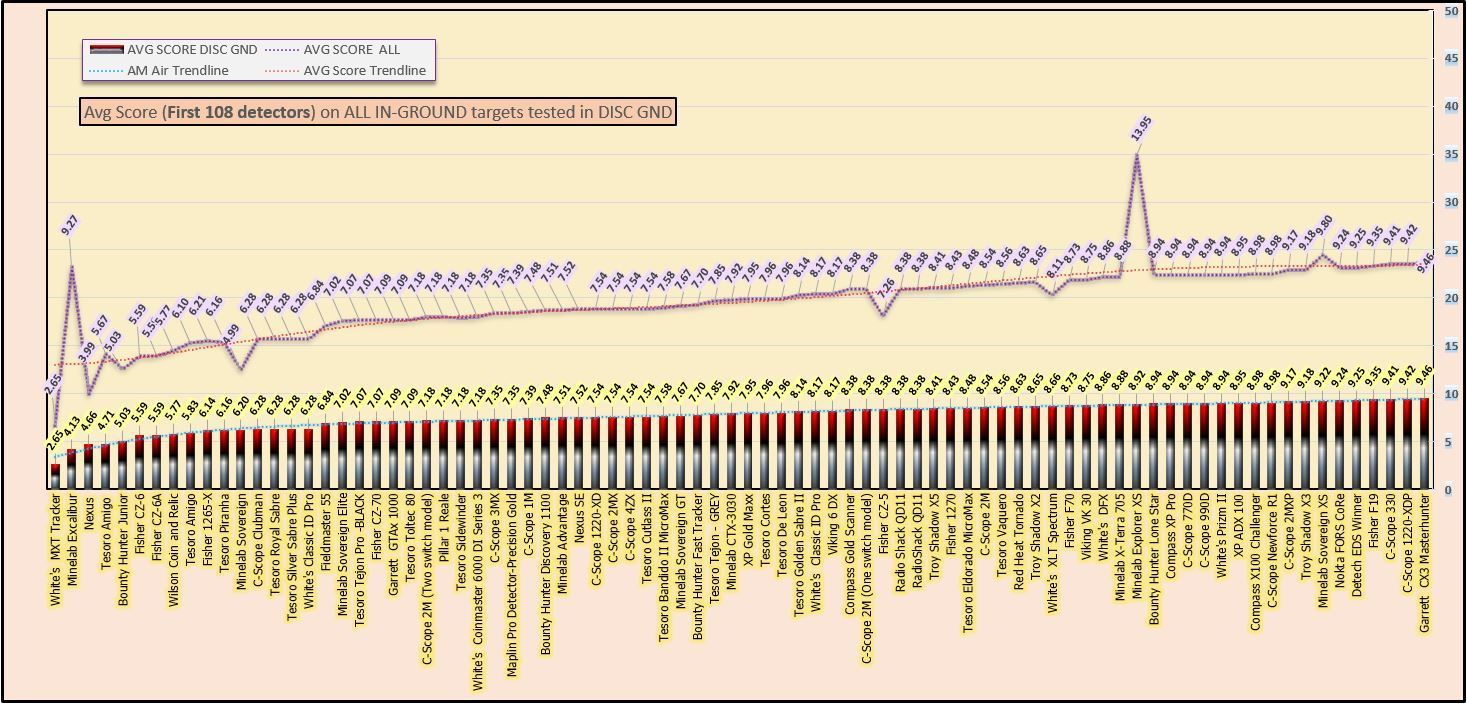
The last 108 detectors tested (total of 216) in DISC GND configuration (the scales for the bars are different in this chart)

All detectors tested on targets in the AIR while configured for ALL METAL or NO DISC (lower score is better)
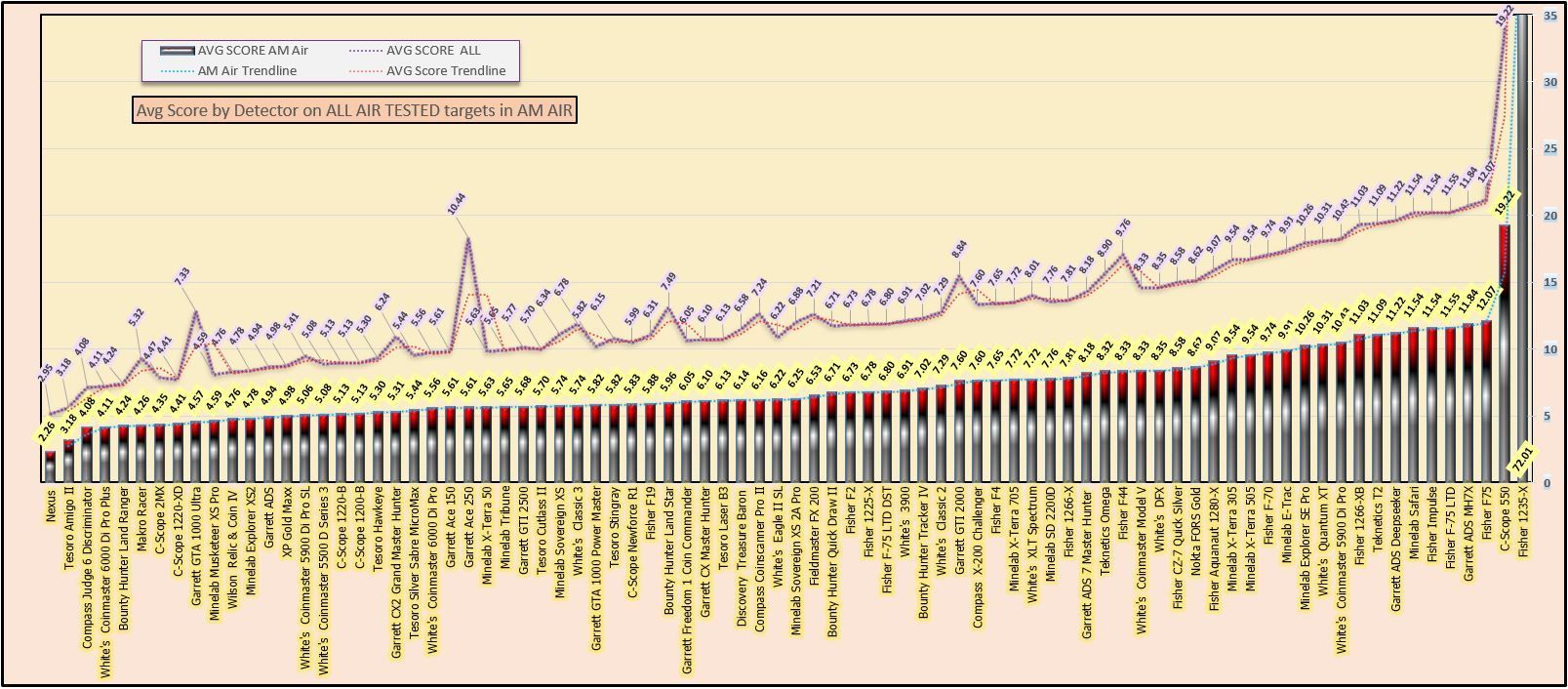
All detectors tested on various junk targets made from different metals in the ground (GND) using a DISC setting (discrimination)
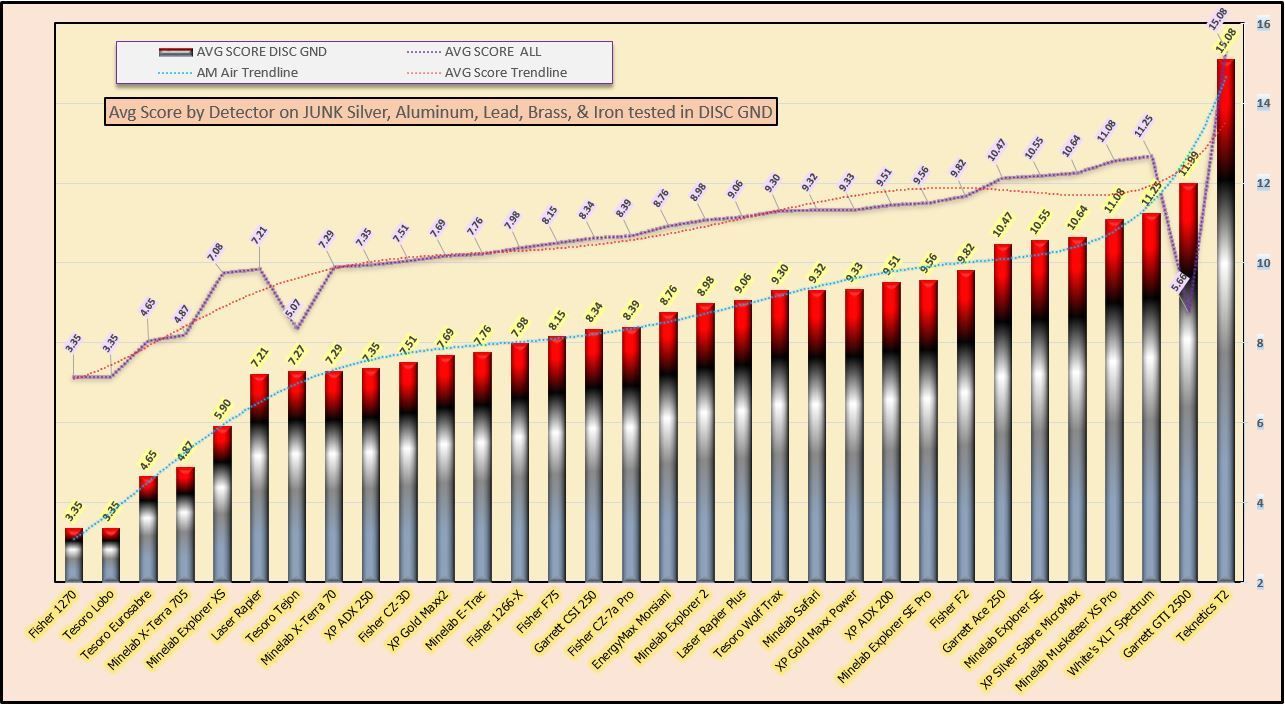
All detectors tested on All targets available (for each particular detector targets will vary) in Mineralized soil (GND) while operating in AM (All Metal mode)
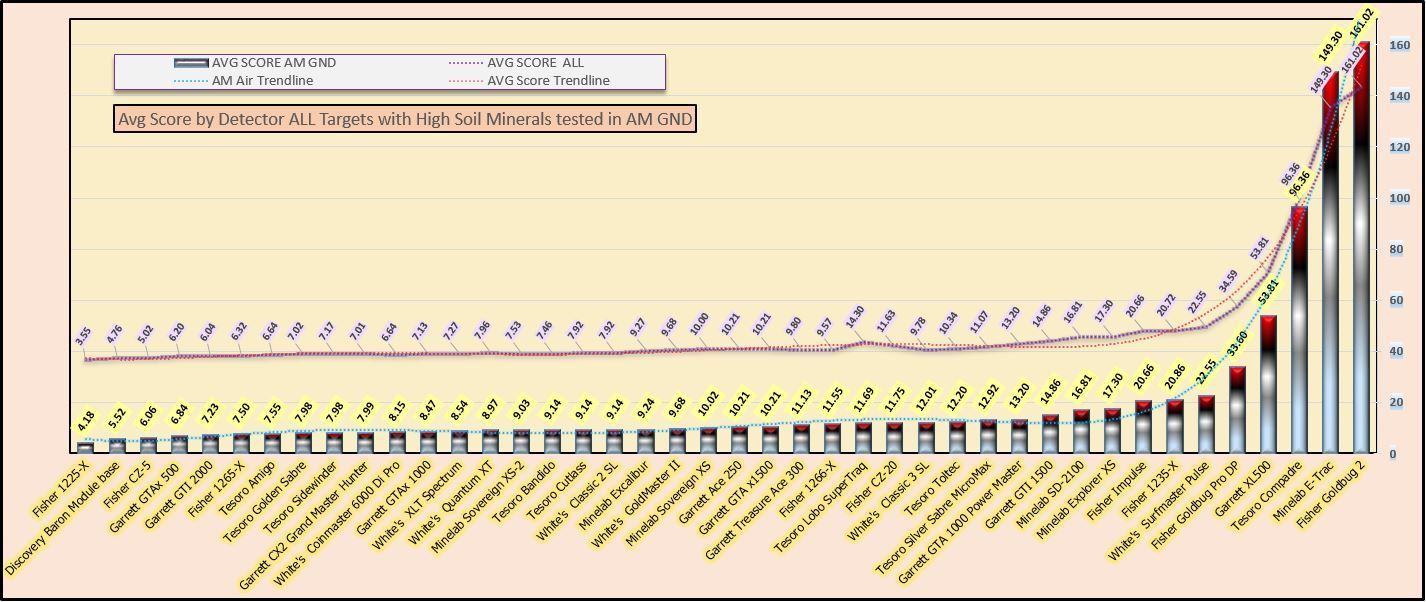
All detectors tested on All Targets (available for each particular detector) in Mineralized ground (GND) while using some amount of DISC
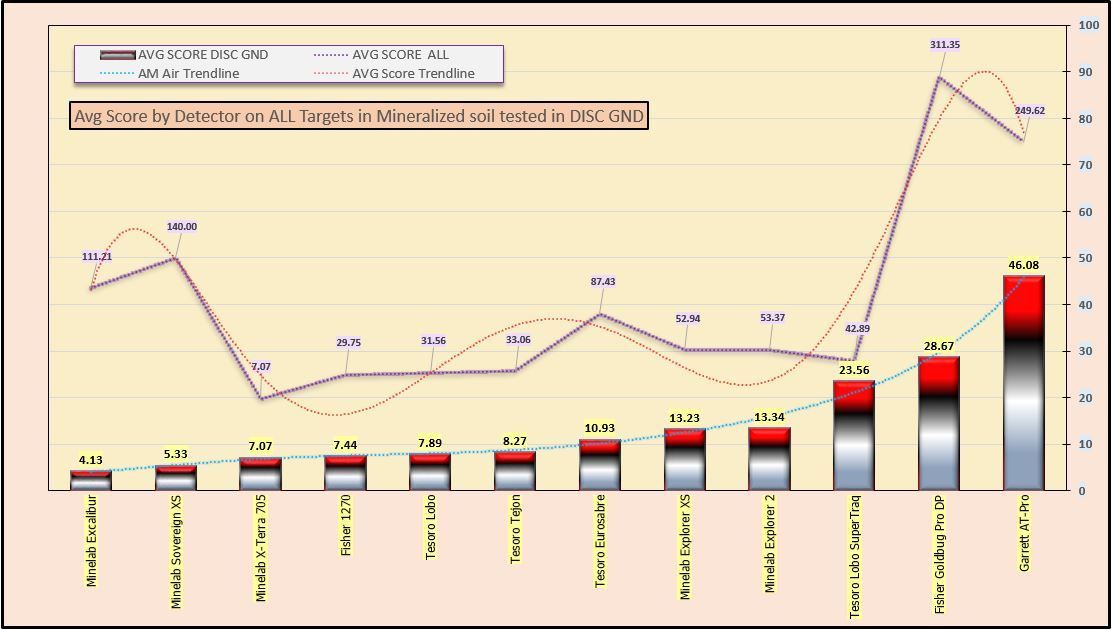
All detectors tested on Coin targets in the air (AIR) using some amount of DISC (discrimination)
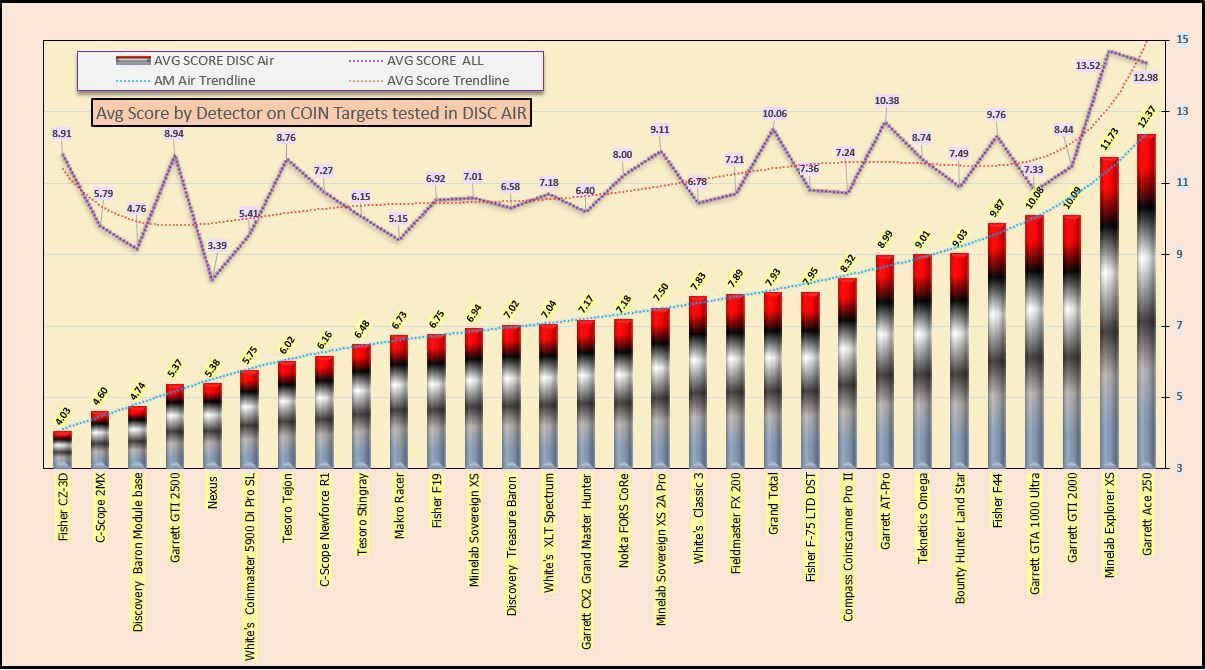
All detectors tested on Coin targets in the air (AIR) while operating in AM mode (All Metal)
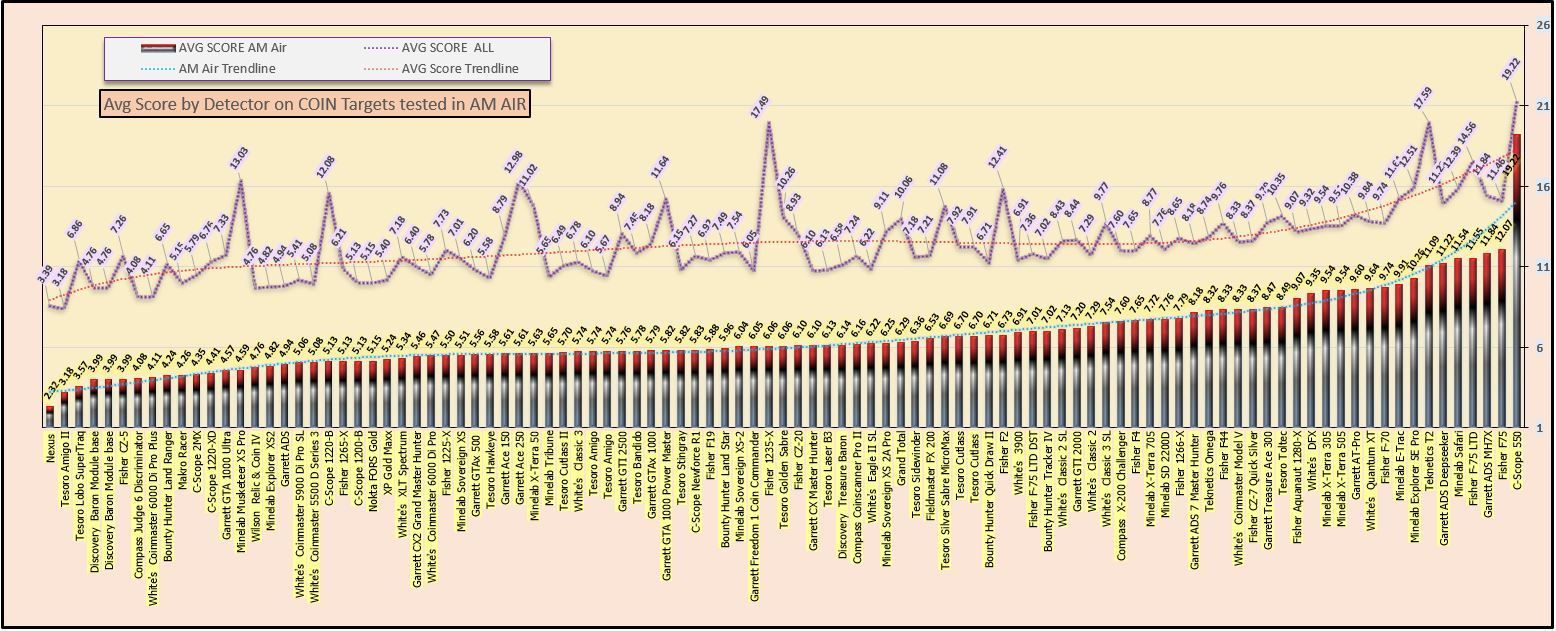
All detectors tested on Coin targets in the ground (GND) while operating in AM mode (All Metal)
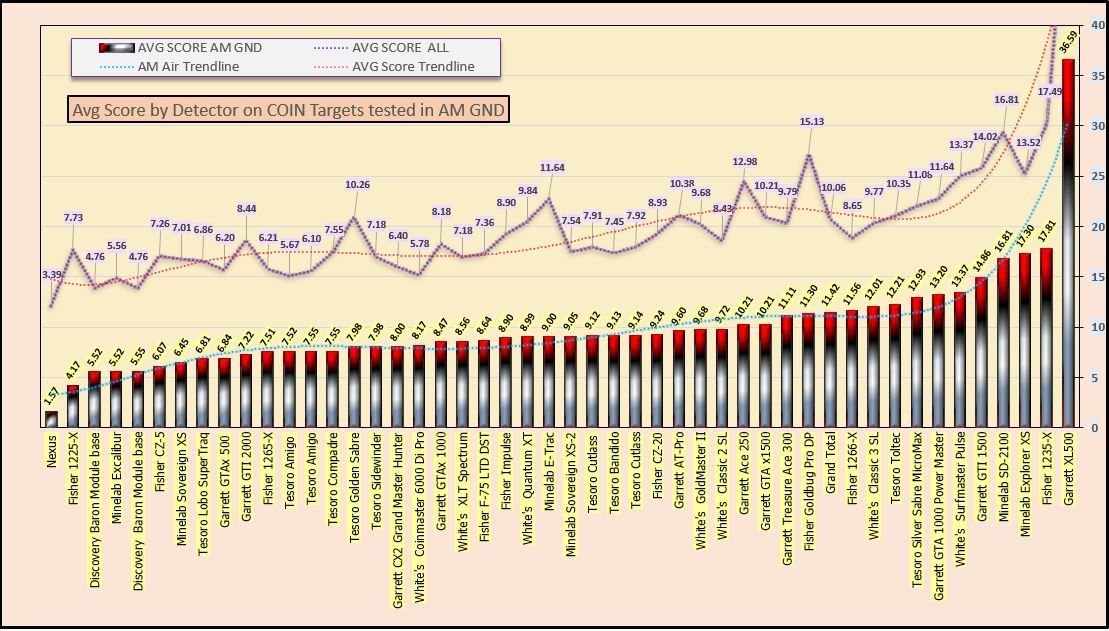
All detectors tested on Gold Coins in the air (AIR) while in AM (All Metal mode)
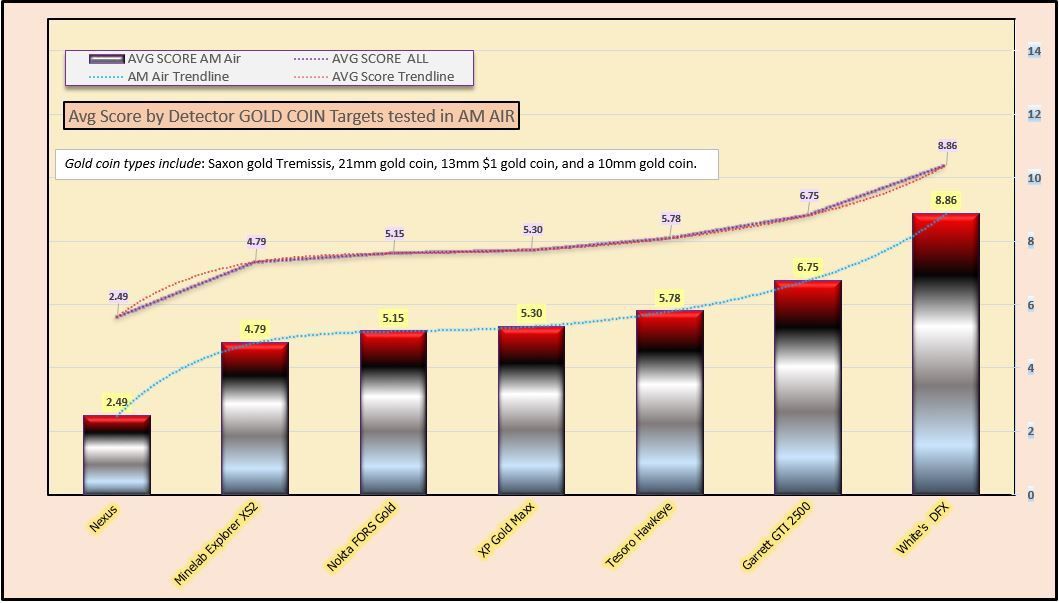
All detectors tested on Gold Coins in the ground (GND) while in AM (All Metal mode)
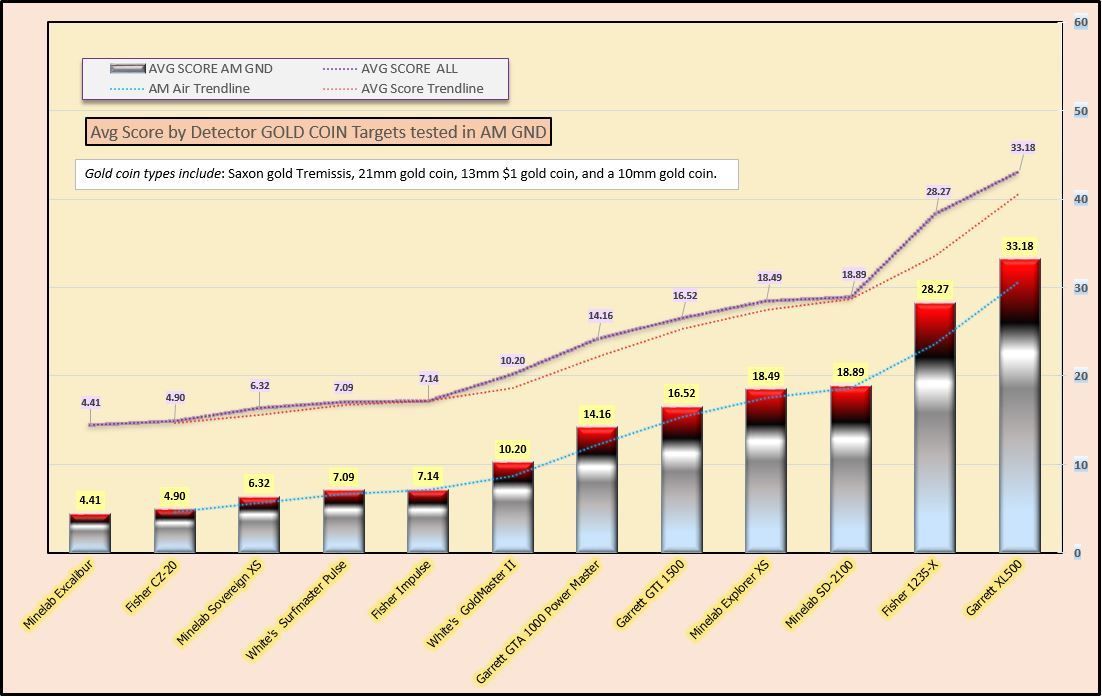
All detectors tested on Silver Coins in the ground (GND) while in DISC (some amount of discrimination was used, usually enough to eliminate iron nails)
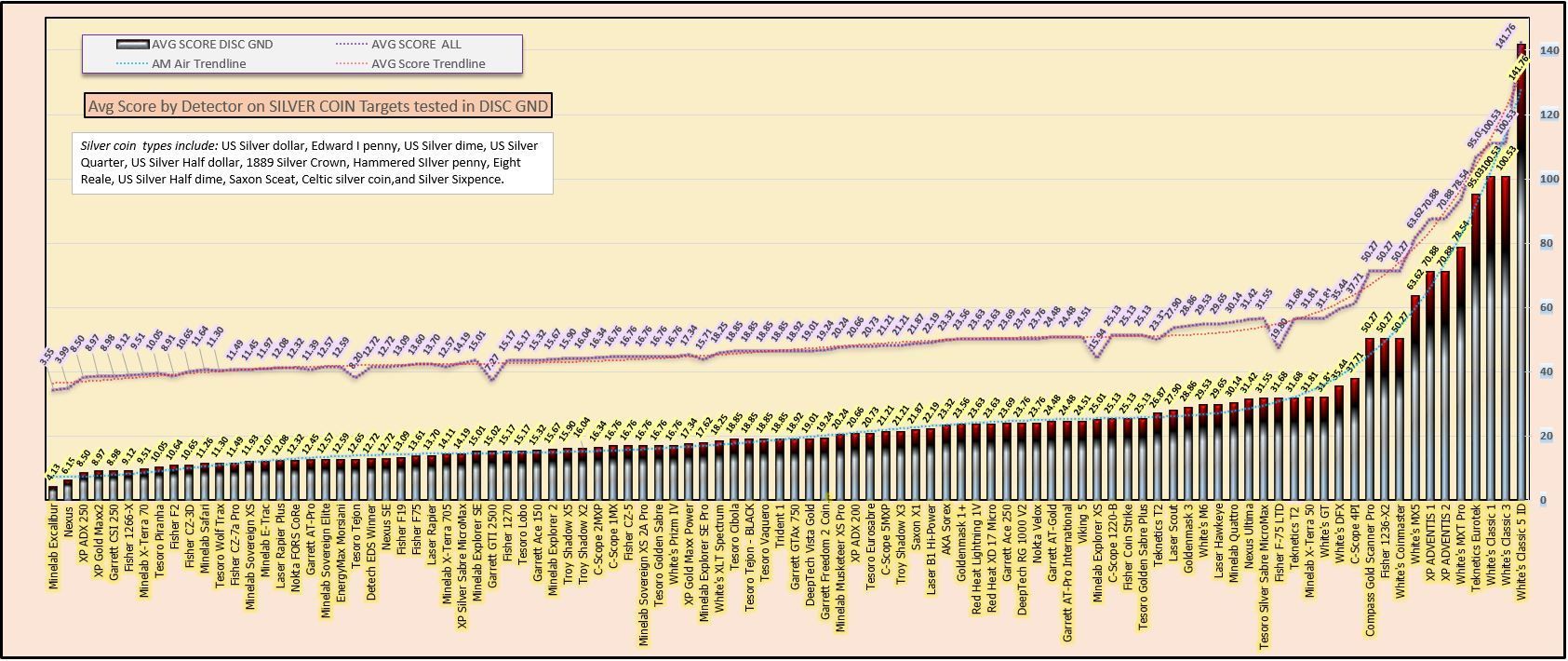
All detectors tested on Coin targets that have Conductive Values (Co on E-Trac/CTX) of less than 40 (i.e., below avg conductivity), in the ground (GND) while operating in AM (All Metal mode)

All detectors tested on Coin targets that have Conductive Values (Co on E-Trac/CTX) of GTE to 40 (i.e., above avg conductivity), in the ground (GND) while operating in AM (All Metal mode)
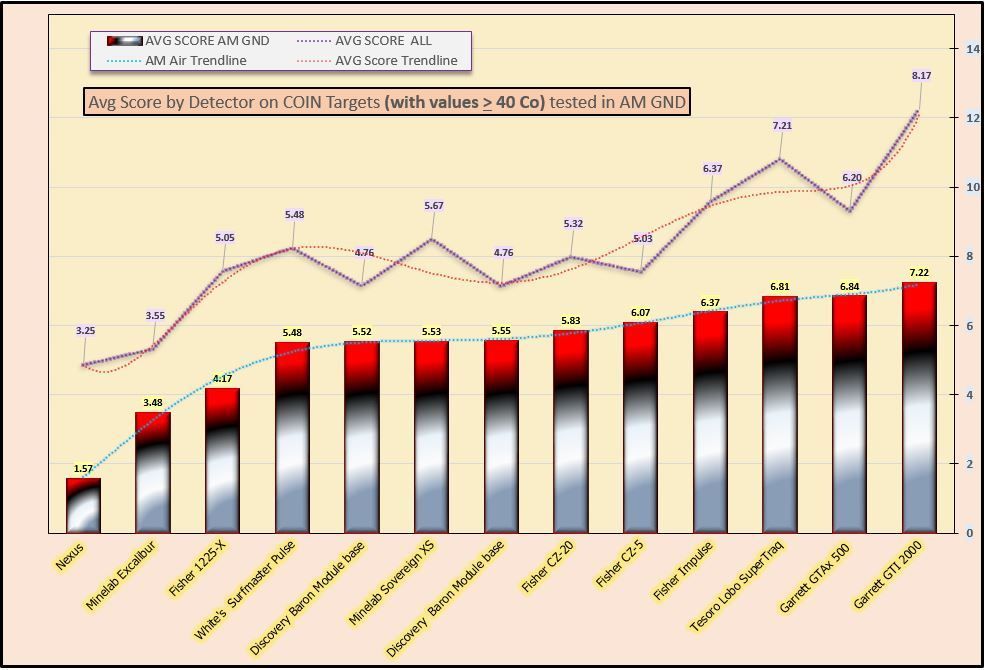
The first 108 detectors (charts are split to allow details to be seen) tested on Coin targets in the ground (GND) while using some amount of DISC (discrimination)
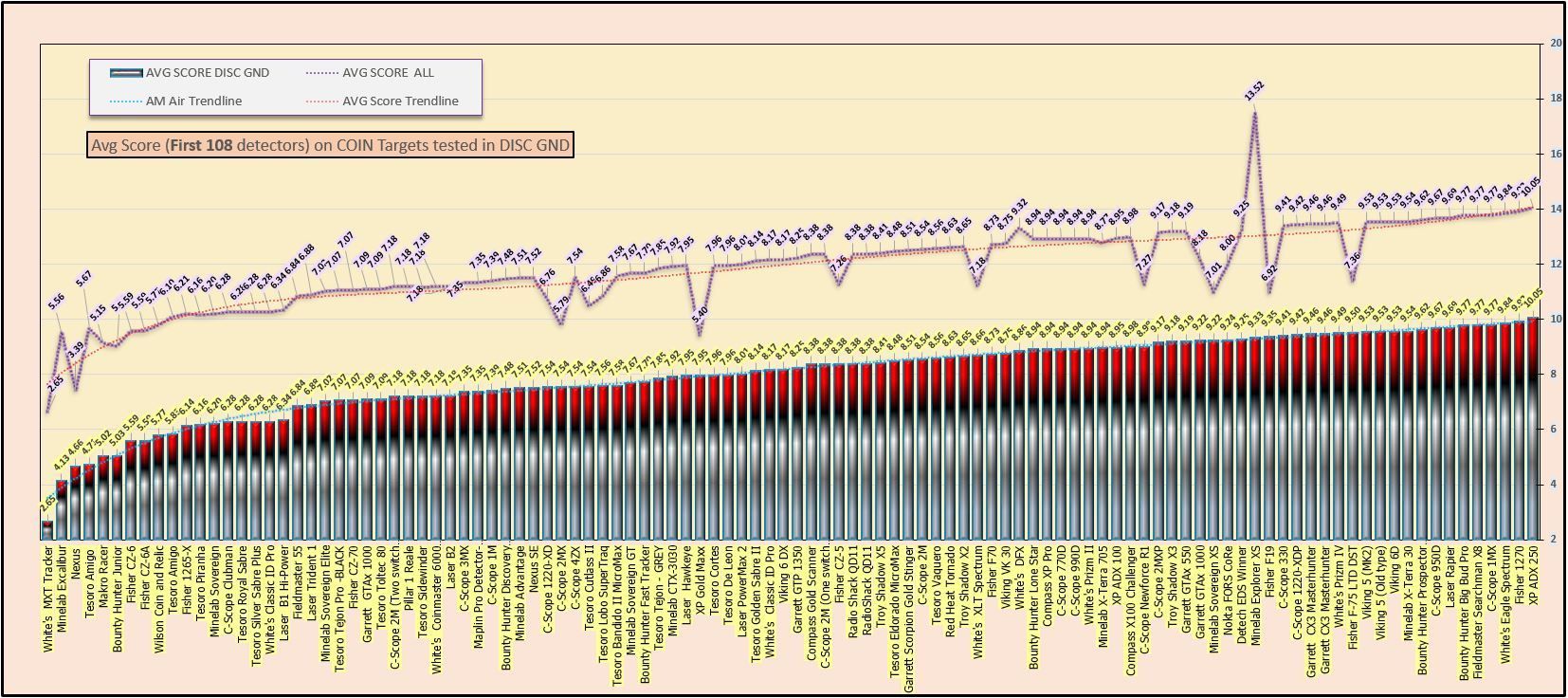
The last 108 detectors (charts are split to allow details to be seen) tested on Coin targets in the ground (GND) while using some amount of DISC (discrimination)
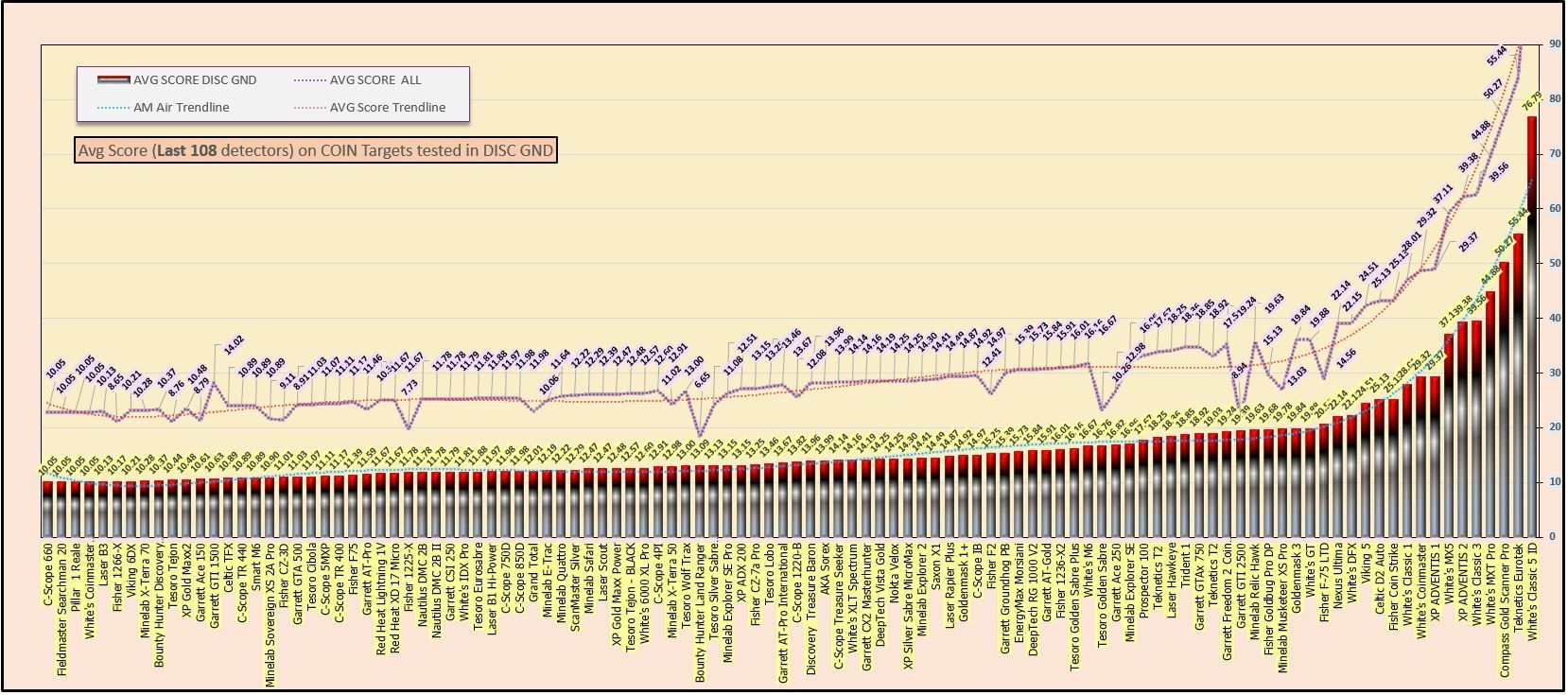
All detectors tested on several different smallish Jewelry targets in the ground (GND) while in DISC (some discrimination was used)
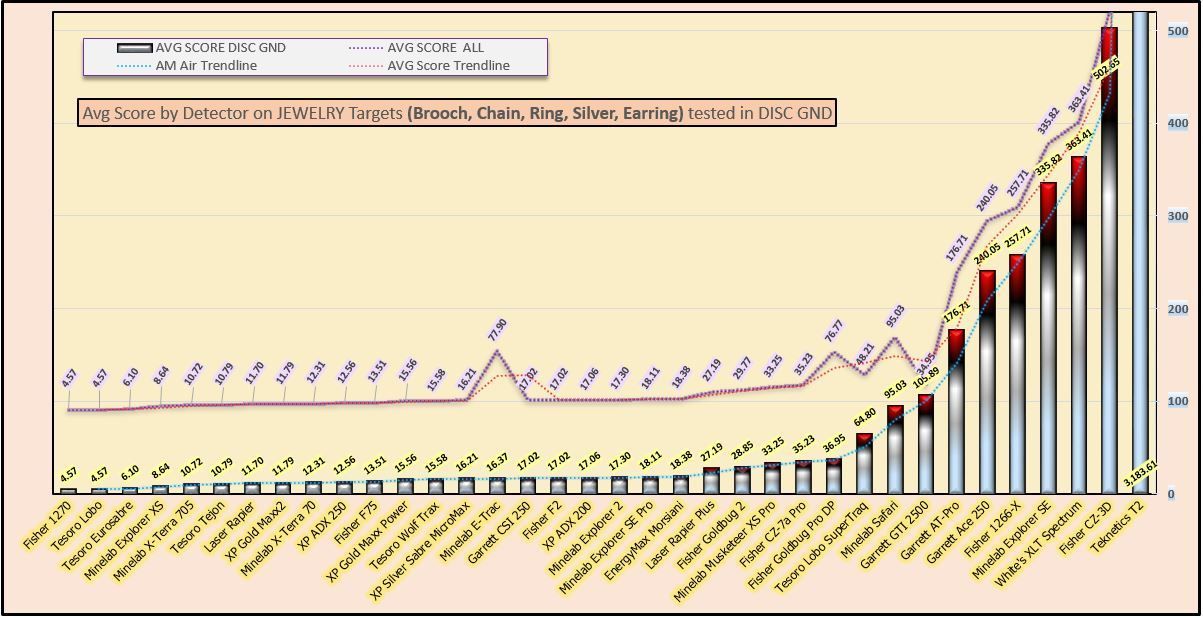
All detectors tested on several different smallish Jewelry targets in the ground (GND) while in AM (All Metal or no DISC setting)

All detectors tested on several smallish Jewelry targets in the AIR (air test) in AM (All Metal or no DISC Setting)
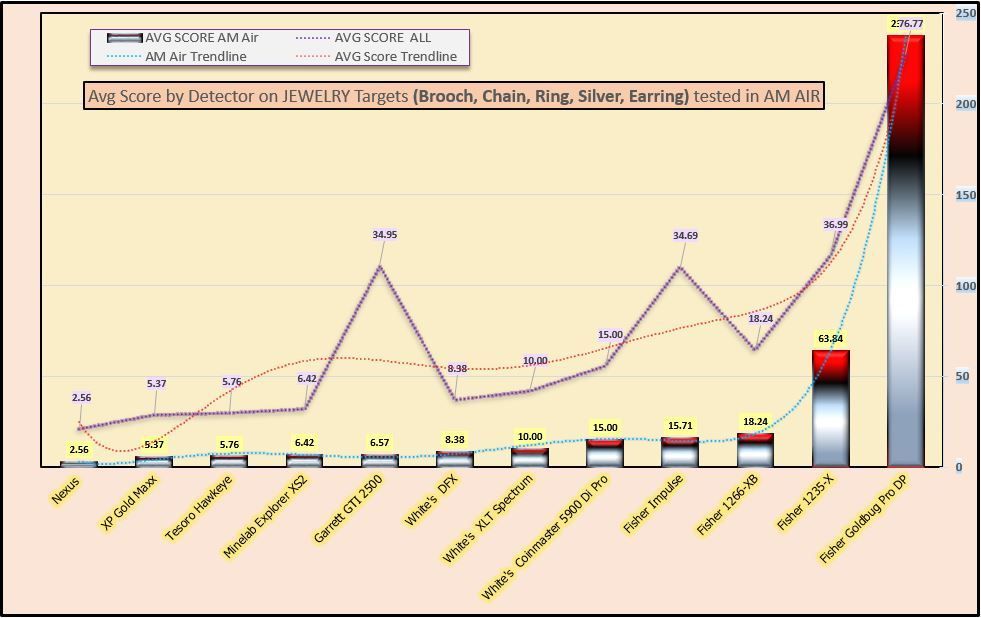
All detectors tested on a single antique brooch in the ground (GND) using a DISC setting (a brooch is a small jewelry piece found with or without a pin)
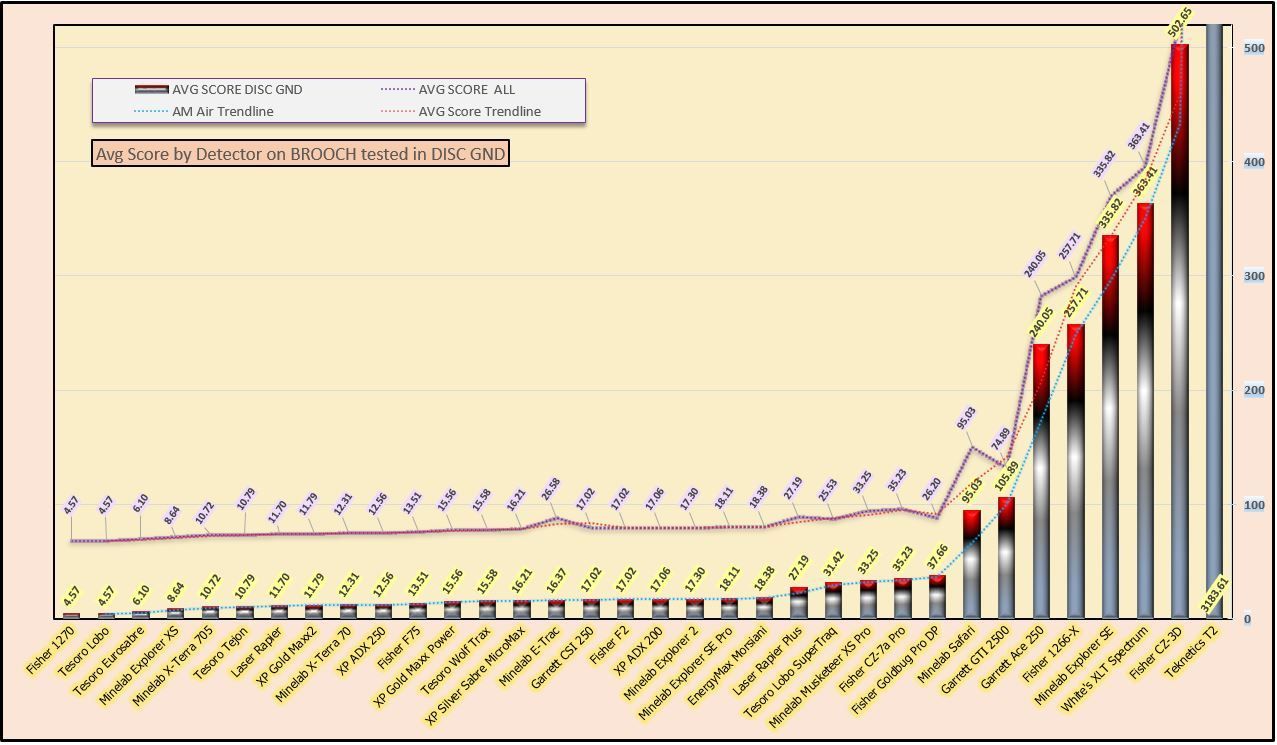
Johnnyanglo
1. Targeted test done in the air (an air test)
2. Targeted test done in the ground (performed in soil, disturbed or undisturbed)
A. Test done with Discrimination (DISC) set to some amount (usually set not to respond to an iron nail or iron object)
B. Test done without DISC selected or in ALL METAL (AM)
Combining the possibilities, there are only four types of detector depth/distance testing:
1. DISC GND (with some amount of discrimination set and target in the dirt/ground/sand)
2. DISC AIR (with some amount of discrimination set and target in the air)
3. AM GND (no DISC set or in ALL METAL mode and target in the dirt/ground/sand)
4. AM AIR (no DISC set or in ALL METAL mode and target in the air)
I created a database and recorded findings and any testing methodology, settings, or coils used during the testing as provided. Some tests did not provide much information - if it was too flimsy or sloppily administered the data was not used. Even so, there are many factors that affect testing and it is doubtful those performing the tests made any grand effort to eliminate all possible errors. So use the charts below but understand that where sample size is small, errors can be large. Not all detectors were tested in all possible configurations (see 1 - 4 above) so some charts will have fewer detectors (those without data on a particular target or testing type are filtered out and not listed).
Obviously, different coil sizes and designs used in testing affect depth and target sensitivity, so it was necessary to normalize the coils by calculating coil surface area and relate it to depth/distance, to provide an efficiency score. There are no depths recorded in these charts. The numbers you see are rather each detector's efficiency score measured against a particular target or group of similar targets, soil conditions, or some other filter. The lower the score the more efficient that detector (where high efficiency means the target is attained deeper/further away (low score) and poor efficiency means a target is attained shallower/closer to coil (high score). Therefore, the best detectors will have the most efficient coil/detector design and yield the lowest score (imagine it's like golf, the lower your score the better/more efficient your performance).
Each chart will have vertical bars running along the x-axis representing the efficiency score for that detector and a line above it which is the detector's overall score on all targets (for comparison). For example, the bars could show performance in DISC setting measured in the ground (GND) while the curved line above is performance in all settings on all targets. Note: The scale of the curved line is not the same as the bars - it was necessary to keep the two separated so the line is always above the bar. Likewise, the bar heights vary from chart to chart as needed to make the data fit ... you should compare the efficiency scores as the bar heights may lead to incorrect conclusions.
Note: If your favorite detector doesn't do well it may be that the test target was difficult to attain, as targets differed by size, conductivity, and orientation to the coil and/or soil conditions may have been harsh. This is important to remember when comparing a detector chart listed as ALL TARGETS - they are not all identical targets, but 103 different targets. Your particular detector may have had a tough target to resolve during testing and scored poorly while another may have had it easy and scored better (no detector was tested on all 103 targets, so ALL TARGETS means all of a subset of targets for each detectors). When comparing ALL TARGETS, a detector that does poorly as compared to others may in fact be better than the others, if they were to be compared under identical conditions.
The 20 charts the follow were made to help delineate the performance characteristics of the tested detectors on various target groups (remember: lower values are better). Enjoy:
The first 108 detectors tested (charts are split to allow details to be seen) ranked by efficiency (lower is better) as tested in DISC GND configuration

The last 108 detectors tested (total of 216) in DISC GND configuration (the scales for the bars are different in this chart)

All detectors tested on targets in the AIR while configured for ALL METAL or NO DISC (lower score is better)

All detectors tested on various junk targets made from different metals in the ground (GND) using a DISC setting (discrimination)

All detectors tested on All targets available (for each particular detector targets will vary) in Mineralized soil (GND) while operating in AM (All Metal mode)

All detectors tested on All Targets (available for each particular detector) in Mineralized ground (GND) while using some amount of DISC

All detectors tested on Coin targets in the air (AIR) using some amount of DISC (discrimination)

All detectors tested on Coin targets in the air (AIR) while operating in AM mode (All Metal)

All detectors tested on Coin targets in the ground (GND) while operating in AM mode (All Metal)

All detectors tested on Gold Coins in the air (AIR) while in AM (All Metal mode)

All detectors tested on Gold Coins in the ground (GND) while in AM (All Metal mode)

All detectors tested on Silver Coins in the ground (GND) while in DISC (some amount of discrimination was used, usually enough to eliminate iron nails)

All detectors tested on Coin targets that have Conductive Values (Co on E-Trac/CTX) of less than 40 (i.e., below avg conductivity), in the ground (GND) while operating in AM (All Metal mode)

All detectors tested on Coin targets that have Conductive Values (Co on E-Trac/CTX) of GTE to 40 (i.e., above avg conductivity), in the ground (GND) while operating in AM (All Metal mode)

The first 108 detectors (charts are split to allow details to be seen) tested on Coin targets in the ground (GND) while using some amount of DISC (discrimination)

The last 108 detectors (charts are split to allow details to be seen) tested on Coin targets in the ground (GND) while using some amount of DISC (discrimination)

All detectors tested on several different smallish Jewelry targets in the ground (GND) while in DISC (some discrimination was used)

All detectors tested on several different smallish Jewelry targets in the ground (GND) while in AM (All Metal or no DISC setting)

All detectors tested on several smallish Jewelry targets in the AIR (air test) in AM (All Metal or no DISC Setting)

All detectors tested on a single antique brooch in the ground (GND) using a DISC setting (a brooch is a small jewelry piece found with or without a pin)

Johnnyanglo
|
Re: Detector Comparisons - Internet Test Results Compilation November 09, 2015 05:14AM |
Registered: 14 years ago Posts: 8,155 |
|
Re: Detector Comparisons - Internet Test Results Compilation November 09, 2015 10:27AM |
Registered: 13 years ago Posts: 1,917 |
A lot of work has gone into that, well done for even contemplating it.
But the results make baffling reading, I struggled to see any pattern that made sense. I re-read your method, and this caught my attention:
"it was necessary to normalize the coils by calculating coil surface area and relate it to depth/distance"
I think this is where the flaw is. If you are trying to compensate for coil size differences, I think you need to consider the square-root of the coil diameter. The obtained depth of coils is not even proportional to their diameter, in my opinion. It would probably be fair to say depth would be proportional to the diameter if the target diameter was also increased proportionally. But as the targets are unchanged, here, a much less strong relationship is seen.
But the results make baffling reading, I struggled to see any pattern that made sense. I re-read your method, and this caught my attention:
"it was necessary to normalize the coils by calculating coil surface area and relate it to depth/distance"
I think this is where the flaw is. If you are trying to compensate for coil size differences, I think you need to consider the square-root of the coil diameter. The obtained depth of coils is not even proportional to their diameter, in my opinion. It would probably be fair to say depth would be proportional to the diameter if the target diameter was also increased proportionally. But as the targets are unchanged, here, a much less strong relationship is seen.
|
Re: Detector Comparisons - Internet Test Results Compilation November 09, 2015 11:00AM |
Registered: 14 years ago Posts: 3,948 |
|
Re: Detector Comparisons - Internet Test Results Compilation November 09, 2015 12:05PM |
Registered: 12 years ago Posts: 6,830 |
As usual Johnny, your post reflect your talents and intelligence. Some nice looking graphs!!!
I guess my question is what stands out to you, meaning for example:
A summary--- which of the oldies but goodies stand out in certain aspects, and which of the modern stand out in certain aspects???
And maybe I should ask this question, how does DD coils vs Concentric coils play into the final results. I guess what I'm asking, since I haven't owned, used or are even totally familiar with all detectors depicted in your graphs; are DD coils and concentric coils available for all and could this skew results between comparing different detectors????
I guess my question is what stands out to you, meaning for example:
A summary--- which of the oldies but goodies stand out in certain aspects, and which of the modern stand out in certain aspects???
And maybe I should ask this question, how does DD coils vs Concentric coils play into the final results. I guess what I'm asking, since I haven't owned, used or are even totally familiar with all detectors depicted in your graphs; are DD coils and concentric coils available for all and could this skew results between comparing different detectors????
|
Re: Detector Comparisons - Internet Test Results Compilation November 09, 2015 02:00PM |
Registered: 11 years ago Posts: 1,612 |
|
Re: Detector Comparisons - Internet Test Results Compilation November 09, 2015 03:00PM |
Registered: 15 years ago Posts: 3,859 |
|
Re: Detector Comparisons - Internet Test Results Compilation November 09, 2015 03:46PM |
Registered: 13 years ago Posts: 634 |
|
Re: Detector Comparisons - Internet Test Results Compilation November 09, 2015 04:25PM |
Registered: 14 years ago Posts: 2,851 |
|
Re: Detector Comparisons - Internet Test Results Compilation November 09, 2015 06:33PM |
Registered: 13 years ago Posts: 969 |
Wow! Some VERY unexpected and hard to comprehend results. What on earth explains the stratospheric variations and wildly variant differences in performance???? How does a cheap entry machine like the Eurotek kick the butts of nearly all comers in a couple instances??? Is the E-Trac that much better than the Excal in AM Ground Jewelry??? Why are T2 results so different from the F75 which is a more expensive flagship? How did the Goldbug Pro best everyone in AM Air jewelry and top the Goldbug 2 in AM Ground Jewelry (usually considered the king of small jewelry machines)? And so many more do not seem to conform to common expectations.
OK I just reread and see that lowest is best not worst. Still I am stunned that my 705 is that much better than my CZ3D, etc.
Still looking for pieces of my head after the explosion.
Past(or)Tom
Using a Legend, a Deus 2, an Equinox 800, a Tarsacci MDT 8000, & a few others...
with my beloved, fading Corgi, Sadie
Edited 1 time(s). Last edit at 11/09/2015 06:55PM by Pasttom.
OK I just reread and see that lowest is best not worst. Still I am stunned that my 705 is that much better than my CZ3D, etc.
Still looking for pieces of my head after the explosion.

Past(or)Tom
Using a Legend, a Deus 2, an Equinox 800, a Tarsacci MDT 8000, & a few others...
with my beloved, fading Corgi, Sadie
Edited 1 time(s). Last edit at 11/09/2015 06:55PM by Pasttom.
|
Re: Detector Comparisons - Internet Test Results Compilation November 09, 2015 08:28PM |
Registered: 10 years ago Posts: 90 |
|
Re: Detector Comparisons - Internet Test Results Compilation November 10, 2015 02:32AM |
Registered: 9 years ago Posts: 251 |
|
Re: Detector Comparisons - Internet Test Results Compilation November 10, 2015 02:52AM |
Registered: 12 years ago Posts: 6,830 |
|
Re: Detector Comparisons - Internet Test Results Compilation November 10, 2015 02:56AM |
Registered: 11 years ago Posts: 107 |
|
Re: Detector Comparisons - Internet Test Results Compilation November 10, 2015 03:18AM |
Registered: 12 years ago Posts: 552 |
Quote
I think this is where the flaw is. If you are trying to compensate for coil size differences, I think you need to consider the square-root of the coil diameter.
The units for the scores are based on the ratio of the coil surface area in sq. inches and the maximum depth to the target.
A small sized coil with an area of 25 sq. inches that registers 1" has a score of 25
A medium sized coil with an area of 50 sq. inches that registers 2" has a score of 25.
A large sized coil with an area of 100 sq. inches that registers 4" has a score of 25.
Relative to coil size the larger coil should perform better (assuming the target is not below minimum resolution size). Whether the score is "better" is only in relation to the other detectors tested that scored lower and thus "better", regardless of coil size. Thus, a small coil can be more effective than a larger coil if it registers deeper. When I arranged some of the charts I tried to keep the target size relative: coin sized, jewelry sized, etc., since I didn't normalize the targets used. In other words, a larger target will be found deeper than a smaller target, which would skew the results toward machines tested against larger targets (or even more conductive targets).
In a perfect world I'd test each detector against spherical chrome, iron, and aluminum balls of varying sizes - but you gotta use what you have.
There is probably a better way to standardize test results, I'm not sure of what that way is but if someone can think of a way, I'm all ears.
|
Re: Detector Comparisons - Internet Test Results Compilation November 10, 2015 03:37AM |
Registered: 14 years ago Posts: 8,155 |
TNSS
Get in touch with David Keith about the Nexxus
Dixie Metal Detectors
1120 Berwick Trail
Madison, TN 37115
He was used to sell them.. He oes not any longer..Not sure why..
Pretty expensive for a Beep dig unit..
Keith
“I don't care that they stole my idea . . I care that they don't have any of their own”
-Nikola Tesla
Get in touch with David Keith about the Nexxus
Dixie Metal Detectors
1120 Berwick Trail
Madison, TN 37115
He was used to sell them.. He oes not any longer..Not sure why..
Pretty expensive for a Beep dig unit..
Keith
“I don't care that they stole my idea . . I care that they don't have any of their own”
-Nikola Tesla
|
Re: Detector Comparisons - Internet Test Results Compilation November 10, 2015 03:45AM |
Registered: 12 years ago Posts: 6,830 |
I've dealt with as well as talked with David---another dedicated relic hunter btw.
I remember the flack here I think between Nexus about the Blisstool.--Really shameful..
Was just interested if anyone had tested. As I like to keep apprised of the different detectors---those that possess extreme or unusual capabilities.
I remember the flack here I think between Nexus about the Blisstool.--Really shameful..
Was just interested if anyone had tested. As I like to keep apprised of the different detectors---those that possess extreme or unusual capabilities.
|
Re: Detector Comparisons - Internet Test Results Compilation November 10, 2015 03:50AM |
Registered: 14 years ago Posts: 8,155 |
|
Re: Detector Comparisons - Internet Test Results Compilation November 10, 2015 04:48AM |
Registered: 13 years ago Posts: 1,917 |
"The units for the scores are based on the ratio of the coil surface area in sq. inches and the maximum depth to the target.
A small sized coil with an area of 25 sq. inches that registers 1" has a score of 25
A medium sized coil with an area of 50 sq. inches that registers 2" has a score of 25.
A large sized coil with an area of 100 sq. inches that registers 4" has a score of 25."
Yes, that's what I thought you had done. I think this is wrong. Going with my "square-root of coil diameter" suggestion earlier, these example results would end up re-written as:
The units for the scores are based on the ratio of the square-root of the coil size in inches, and the maximum depth to the target. Specifically,:
Score = 10.5 x (root of diameter) / depth. (this is designed so the 'small coil' figures match yours)
A small coil with an area of 25 sq. in. (diameter = 5.6" ) that registers 1" has a score of 25
A medium coil with area of 50 sq. in. (diameter = 8.0" ) that registers 2" has a score of 14.8
A large coil with area of 100 sq. in. (diameter = 11.3" ) that registers 4" has a score of 8.8
It would be interesting to see how this made the charts appear. Clearly, having the Bounty Hunter Junior as one of the top performers (right alongside a Makro Racer) is odd, I think your coil-size compensation strategy is the cause.
Edited 3 time(s). Last edit at 11/10/2015 01:27PM by Pimento.
A small sized coil with an area of 25 sq. inches that registers 1" has a score of 25
A medium sized coil with an area of 50 sq. inches that registers 2" has a score of 25.
A large sized coil with an area of 100 sq. inches that registers 4" has a score of 25."
Yes, that's what I thought you had done. I think this is wrong. Going with my "square-root of coil diameter" suggestion earlier, these example results would end up re-written as:
The units for the scores are based on the ratio of the square-root of the coil size in inches, and the maximum depth to the target. Specifically,:
Score = 10.5 x (root of diameter) / depth. (this is designed so the 'small coil' figures match yours)
A small coil with an area of 25 sq. in. (diameter = 5.6" ) that registers 1" has a score of 25
A medium coil with area of 50 sq. in. (diameter = 8.0" ) that registers 2" has a score of 14.8
A large coil with area of 100 sq. in. (diameter = 11.3" ) that registers 4" has a score of 8.8
It would be interesting to see how this made the charts appear. Clearly, having the Bounty Hunter Junior as one of the top performers (right alongside a Makro Racer) is odd, I think your coil-size compensation strategy is the cause.
Edited 3 time(s). Last edit at 11/10/2015 01:27PM by Pimento.
|
Re: Detector Comparisons - Internet Test Results Compilation November 10, 2015 11:43AM |
Registered: 17 years ago Posts: 10,071 |
|
Re: Detector Comparisons - Internet Test Results Compilation November 10, 2015 01:43PM |
Registered: 10 years ago Posts: 1,194 |
what a massive effort! Too massive. Too much variability and questionability of data in to give much regard to data out. Should be marked "for entertainment only."
Impossible to draw any well reasoned conclusions.
not knocking the effort, mind you, just stating the impossibility of achieving meaningful results.
Pleasant Garden, NC
AT Max, Nokta Impact, MX Sport, Nokta FORS Relic, GPX 4800, Infinium, Racer, Deus, F75SE, Nautilus DMC II (order of acquisition, last to first)
Does an archeologist argue with a plow? A bureaucrat with a bulldozer?
Impossible to draw any well reasoned conclusions.
not knocking the effort, mind you, just stating the impossibility of achieving meaningful results.
Pleasant Garden, NC
AT Max, Nokta Impact, MX Sport, Nokta FORS Relic, GPX 4800, Infinium, Racer, Deus, F75SE, Nautilus DMC II (order of acquisition, last to first)
Does an archeologist argue with a plow? A bureaucrat with a bulldozer?
|
Re: Detector Comparisons - Internet Test Results Compilation August 02, 2016 05:07PM |
Registered: 7 years ago Posts: 565 |
Just been reading this very interesting thread,and must admit i am amazed how well the Nexus done,i use a Nexus Standard SE with the dual 9'' coil,its one of these machines that is seen as a complicated machine too master,i will have to say i find that not the case.I dont use it as a every day machine but it comes out to play when i am on pasture permission and i want to go deeper than normal which it does with ease.
How deep do they go,on targets of reasonable size then it often goes down deeper than i am prepared too dig,i use it mainly when i suspect a pot hoard is in the location,they are not the most common detector going,but i do enjoy using mine and that basically is the bottom line.
How deep do they go,on targets of reasonable size then it often goes down deeper than i am prepared too dig,i use it mainly when i suspect a pot hoard is in the location,they are not the most common detector going,but i do enjoy using mine and that basically is the bottom line.
|
Re: Detector Comparisons - Internet Test Results Compilation August 02, 2016 06:23PM |
Registered: 8 years ago Posts: 1,104 |
Junk and Disorderly Wrote:
-------------------------------------------------------
> Just been reading this very interesting thread,and
> must admit i am amazed how well the Nexus done,i
> use a Nexus Standard SE with the dual 9'' coil,its
> one of these machines that is seen as a
> complicated machine too master,i will have to say
> i find that not the case.I dont use it as a every
> day machine but it comes out to play when i am on
> pasture permission and i want to go deeper than
> normal which it does with ease.
>
> How deep do they go,on targets of reasonable size
> then it often goes down deeper than i am prepared
> too dig,i use it mainly when i suspect a pot hoard
> is in the location,they are not the most common
> detector going,but i do enjoy using mine and that
> basically is the bottom line
I agree, If the Gubberment. was to write me an open Cheque for research then the Nexus would be the tool to buy, In laymans terms these charts do not relate any anything that I know, As to what they are saying I haven't a clue apart from the first one where it says that the lower number refers to battery consumption and that lower is better, As excellent as they are they don't tell me what I need to know,
From what I have found during testing in the past 12 months "ish" is that where detector companies are struggling to extract more depth from machines, What they have done is make certain models extremely hot on tiny targets and every time I buy the later model of a certain machine I have found that the previous tests are not even close, In the past year alone I have had to buy 3 new sets of scales from the normal prospecting types to laboratory types and then about 10 days ago I had to get a finer set that I can Calibrate when needed,
To be honest real world testing is murder because so many things can change and when you get it all right then something else can throw a spanner in the works
To be Continued, lol.
John.
-------------------------------------------------------
> Just been reading this very interesting thread,and
> must admit i am amazed how well the Nexus done,i
> use a Nexus Standard SE with the dual 9'' coil,its
> one of these machines that is seen as a
> complicated machine too master,i will have to say
> i find that not the case.I dont use it as a every
> day machine but it comes out to play when i am on
> pasture permission and i want to go deeper than
> normal which it does with ease.
>
> How deep do they go,on targets of reasonable size
> then it often goes down deeper than i am prepared
> too dig,i use it mainly when i suspect a pot hoard
> is in the location,they are not the most common
> detector going,but i do enjoy using mine and that
> basically is the bottom line
I agree, If the Gubberment. was to write me an open Cheque for research then the Nexus would be the tool to buy, In laymans terms these charts do not relate any anything that I know, As to what they are saying I haven't a clue apart from the first one where it says that the lower number refers to battery consumption and that lower is better, As excellent as they are they don't tell me what I need to know,
From what I have found during testing in the past 12 months "ish" is that where detector companies are struggling to extract more depth from machines, What they have done is make certain models extremely hot on tiny targets and every time I buy the later model of a certain machine I have found that the previous tests are not even close, In the past year alone I have had to buy 3 new sets of scales from the normal prospecting types to laboratory types and then about 10 days ago I had to get a finer set that I can Calibrate when needed,
To be honest real world testing is murder because so many things can change and when you get it all right then something else can throw a spanner in the works
To be Continued, lol.

John.